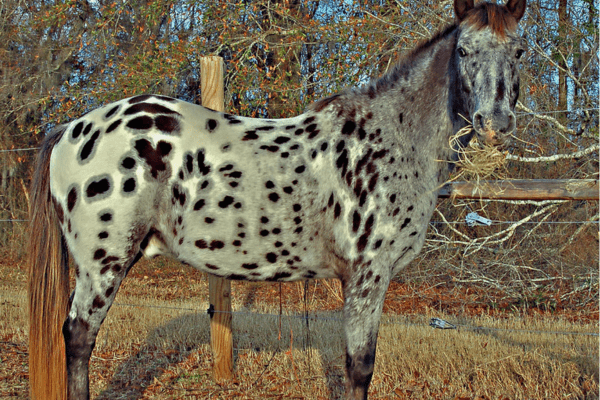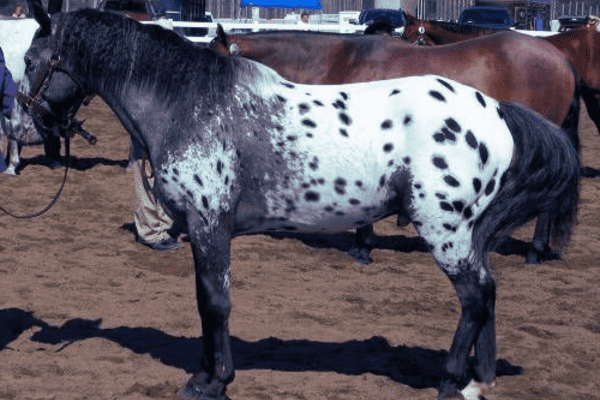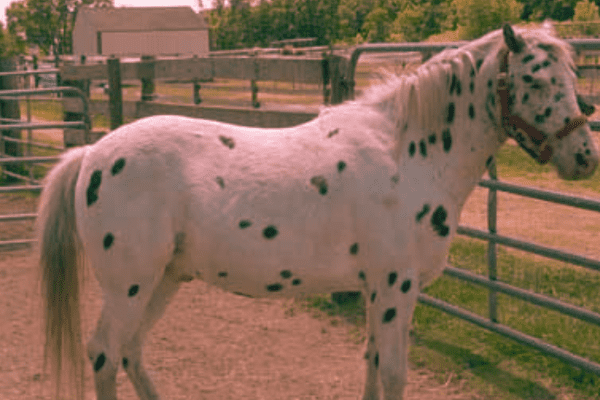Originating in the heartland of Iowa, United States, the Pony of the Americas emerges as a distinct and remarkable breed in the equine world. Established in the 20th century, this breed is celebrated for its compact size and gentle nature, making it an exemplary choice for young equestrians.
With its striking resemblance to a miniature Appaloosa Horse, the Pony of the Americas is not only visually captivating but also demonstrates a remarkable balance of agility and temperament. This relatively modern breed has swiftly gained recognition for its adaptability and suitability as a dependable riding companion for children.
History:
The Pony of the Americas is an exotic breed that originated thanks to Les Boomhower, an Iowa Shetland pony breeder. Beginning their journey back in 1954, this unique equine has since blossomed into something far greater. Over time it has garnered widespread equine world recognition as well as progress.
Origin and Development:
The POA breed was laid at its core with the selection of Black Hand, an elegant crossbred of Arabian, Appaloosa, and Shetland pony breeding lines with striking Appaloosa markings. Boomhower was so taken with Black Hand’s exceptional conformation and temperament that he decided to establish a new breed from this unique crossbred that would combine all its desirable traits.
Formation of Pony of the Americas Club:
In 1954, Boomhower along with several equine enthusiasts established the Pony of the Americas Club to formalize and register Black Hand as the inaugural pony registered to this new breed in equine registry. This momentous occasion signified the birth of a brand new breed.
Initial Development and Standards:
Early years saw increasing interest in the breed with twelve ponies and 23 members joining its registry. The club set goals to create a medium-sized pony suitable for older children and small adults that combined aspects from Appaloosas, Arabians and American Quarter Horses into one pony breed that was ideal for older children and small adults. At first, height standards ranged between 44 to 52 inches (110 to 130 cm); later these height standards expanded as the breed matured.
Evolution of Breed Standards:
Beginning in 1963, height requirements underwent two significant modifications; first to 46 to 54 inches (120 to 140 cm) before their upper limit was increased to 56 inches in 1985 – both changes reflecting a commitment to refining breed conformance more closely with desired stock horse appearance.
Registration and Expansion:
In its first fifteen years of existence, the breed club registered an impressive 12,500 ponies. As time progressed, Shetland bloodlines gradually diminished in influence – moving closer towards fulfilling founders’ vision of creating an affordable yet stocky horse breed with small feet. Meanwhile, popularity and appeal continued to expand nationally and internationally.
National Recognition and the Hall of Fame:
The Pony of the Americas Club received significant momentum by hosting its inaugural national convention in 1988. Two years later, to recognize exceptional members and ponies, they established a Hall of Fame. By 2012, this registry had reached over 50,000 ponies–a testament to its continued appeal.
Diverse Equine Activities:
Although originally bred for Western riding and stock purposes, the POA quickly proved its versatility. They excelled in endurance riding, three-day eventing, show hunter competitions, driving and dressage – their jumping prowess further demonstrated their adaptability across various equestrian disciplines.
Changes to Competition Rules:
At first, competitions held by the breed club were restricted to riders under 16; as their popularity spread further among all age groups, however, the age limit was raised to 18 in 1973 and eventually adults could show two to four year-old horses under saddle to reflect this breed’s expanding role within equestrian culture.
The Pony of the Americas stands as a shining example of innovative breeding, transitioning from regional breeder’s visions into an internationally respected equine breed.
Their journey from Shetland pony breeders’ visions into beloved riders of all ages shows a dedication and passion towards understanding genetics and needs for horses that endures for over 50 years. Today, POA continues to thrive by adapting to changes in equestrian sports and leisure while upholding their heritage appeal.


Breed Characteristics:
The Pony of the Americas, renowned for its distinct equine characteristics, upholds strict standards in its registry to preserve these unique features.
Attractive Appaloosa Coloration: Registration in the Pony of the Americas Club requires striking Appaloosa coloring that can be seen from at least 40 feet (12 meters away. This vibrant hue is marked by leopard complex features like mottled skin around eyes, muzzle and genital areas; white sclera in eyes; and distinctive hoof stripes or patterns on hooves.
Exclusion of Pinto Ancestry: In order to maintain the breed’s purity, the POA takes stringent measures in protecting its Appaloosa coloration by barring any lineage with known Pinto patterns, like American Paint Horse. This rule ensures the preservation of Appaloosa horses’ unique Appaloosa hue from being affected by foreign bloodlines or breeding stock.
Physical Conformation and Build: The POA displays an unusual concave facial profile, distinguishing it from standard pony breeds. Muscular yet robust, its deep chest and well-angled shoulders reflect both strength and agility in its physique.
Height and Breed Phenotype: Standing between 11.2-14 hands (46 to 56 inches; 117-142 cm), the POA more closely resembles small horses than traditional ponies in terms of its physical attributes and appearance; it draws inspiration from American Quarter Horse and Arabian types, offering sturdy yet graceful forms.
Breeding Practices: The registry welcomes offspring of registered POAs as well as crosses with specific breeds such as Connemaras, Galiceno ponies, Australian Stock Horses, Morgans, Thoroughbreds and Appaloosa and Arabian breeds; such crosses will be admitted if they meet each breed’s physical requirements for membership.
Crossbreeding with Other Breeds: The POA Club carefully considers any crosses with breeds such as Quarter ponies, Shetland ponies, Anglo-Arabs, Spanish Mustangs or Welsh ponies as individual cases to ensure that each breed’s distinctive features remain preserved even within crossbred specimens. This systematic evaluation guarantees their distinctive features remain protected even in crossbred offspring.
Overall, the Pony of the Americas represents an ideal blend of aesthetic elegance and functional agility, epitomized by vibrant Appaloosa color patterns and robust physique. Furthermore, its stringent registration criteria demonstrate their dedication to maintaining these distinctive attributes that give rise to such respect within equine circles.
Temperament:
The Pony of the Americas (POA) breed stands as a testament to their distinctive breeding, selecting foundational bloodlines carefully. Renowned for their friendly and cooperative disposition, these ponies have long been favorites among equine enthusiasts looking for reliable mounts suitable for younger or less experienced riders.
Gentle and Patient: The POA is known for its calm and patient temperament, making them the ideal choice for children and novice riders. Their gentle nature creates a safe learning and development environment in horsemanship.
Intelligent and Trainable: One of the standout characteristics of POA dogs is their intelligence. This breed is widely recognized for their quick learning ability and responsiveness to training, making them perfect candidates for trail riding as well as competitive events.
Friendly and Sociable: POA horses are known for being exceptionally friendly and social, both towards humans and other horses alike. This makes for pleasant companionship that lends itself well to therapeutic riding programs or community events.
Enthusiastic and Engaged: POAs are well known for their lively personalities. While their calm disposition ensures safe riding experiences, their active personalities make for engaging rides. Their zest for activity makes riding them engaging and enjoyable; yet this energy remains well balanced with their ability to remain calm for an enjoyable experience.
Versatile and Adaptable: POAs are known for being both physically versatile and temperamentally adaptable, making them suitable for riders of various interests and skill levels. Their adaptability extends even beyond physical abilities – their temperament adapts well in different environments such as serene trail rides or vibrant competitive arenas. This adaptability also allows POAs to meet riders with various interests or skill levels.
Loyal and Trustworthy: POA ponies are widely known for their loyalty and trustworthiness, creating strong bonds with their handlers or riders and inspiring a sense of partnership and mutual respect between all involved. Their loyalty makes them much more than recreational or competition horses – they become lifelong companions!

Uses:
What sets the POA apart is its versatility. These ponies shine in all forms of show ring competition – Western pleasure, jumping and driving disciplines can all be performed with equal ease on this smart pony with its intelligence and eagerness to please.
They have proven popular at competitive events – yet their talents extend far beyond that arena – known for its sure-footedness on varied terrains as a trail pony for outdoor adventures alike!

